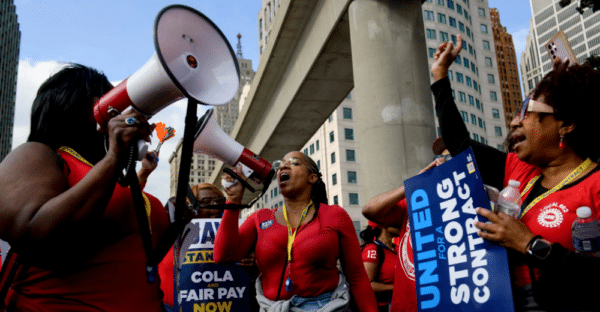The first person quoted in the New York Times’ rundown (9/19/23) on the United Auto Workers strike was a lawyer representing management from Littler Mendelson, the go-to firm for big corporations’ union avoidance.
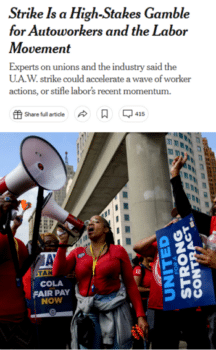
The New York Times (9/19/23) warns that “the strike could inflict collateral damage that creates frustration and hardship among tens of thousands of nonunion workers.”
“Right now, unions are cool,” said Michael Lotito of Littler Mendelson. But they “have a risk of not being very cool if you have a five-month strike in LA and an X-month strike in how many other states.”
The article, “Strike Is a High-Stakes Gamble for Autoworkers and the Labor Movement” highlights the “real pitfalls” of a so-called prolonged strike against the big three automakers: General Motors, Ford and Stellantis (which absorbed Chrysler). “Stand-up” strikes began at limited locations on September 15, and a week later expanded across the country. Without significant progress in negotiations, more workers continue to join the picket line.
The New York Times‘ decision to platform one of the largest union-busting firms in the country, which currently represents management at Starbucks, Apple and Grindr, among others, is in line with other corporate media efforts to uplift CEOs and shareholders, and stoke fears around economic recession, green energy transition and “Bidenomics.”
Blaming Biden
About 13,000 autoworkers walked out in a limited strike at assembly plants in Michigan, Ohio and Missouri at the stroke of midnight on September 14. The workers are asking for a 36% raise in general pay over a span of four years, the end of a tiered system, a 32-hour week with 40 hours of pay, and a return of cost-of-living raises.
This strike comes on the tail of what some deemed “the summer of strikes,” following Hollywood writers’ and actors’ historic work stoppage, and the last-minute labor deal that stopped thousands of UPS workers from striking. Meanwhile, public support for unions is at a multi-decade high. This may explain why corporations and their allies are working overtime to make sure unions “aren’t cool.”
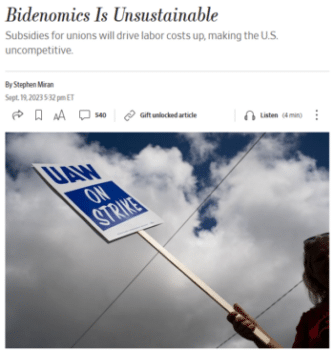
A Wall Street Journal op-ed (9/19/23) endorses the CEO of Ford’s claim that “meeting the United Auto Workers’ demands… would drive the company out of business.” The Journal story (2/2/23) it links to to document Ford’s woes projects a $9—11 billion profit for the company for 2023.
As Stephen Miran of the Exxon-funded Manhattan Institute wrote in the Wall Street Journal (9/19/23):
Strikes by auto workers, healthcare workers, and Hollywood writers and actors demonstrate that key pillars of President Biden’s economic agenda are bad for American industry.
Politicians like Missouri Sen. Josh Hawley and Ohio Sen. J.D. Vance took it a step further, blaming the administration and “Biden’s stupid climate mandates” for the strike’s necessity. Bloomberg (9/14/23) bemoaned Biden being left with limited options to avert a strike and called it “a tough juggling act.” Unlike with the rail workers last year, Biden cannot order autoworkers back to work. It seems the media want Biden to be involved in any way they find possible.
While some blame Biden for the strike, or blame him for being unable to immediately fix it, others are ready to condemn union workers for a future Biden loss in 2024. “I worry about the implications for our economy and for President Biden,” wrote Steven Rattner in the New York Times (9/20/23).
Rattner, who is currently managing Michael Bloomberg’s money, was formerly a part of the Obama administration’s auto task force, and was in charge of negotiating the very concessions that helped inflate executive salaries and initiate stock buybacks. Rattner spends 1,000 words fretting about losses to Big Three profits and telling union members to manage expectations, while brushing off the pay gap between workers and executives as par for the course of doing business in America. Meanwhile, the auto industry’s record-breaking profits flow to the salaries of the CEOs of Ford, Stellantis and GM—$21 million, $25 million and $29 million, respectively.
However, as it turns out, workers are on strike to negotiate a fair contract with those CEOs, not Joe Biden. Despite the most pro-union president’s tepid support for autoworkers and calls for them to be fairly compensated, the situation is not what the Wall Street Journal (9/15/23) called “An Auto Strike Made in Washington.”
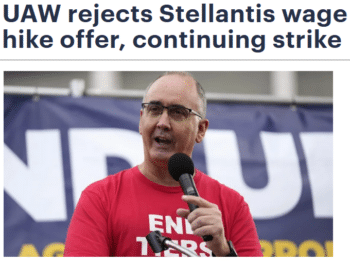
The Hill (9/17/23) failed to note that the “offer” Stellantis made was one the union had turned down before the strike began.
As union president Shawn Fain rightfully declared, “This battle is not about the president” or the former president. While CNBC (9/18/23) claimed in a headline that Fain “downplays White House involvement in strike talks,” they repeated the basic media propaganda that “the union’s demands would cripple the companies,” uplifting Ford CEO Jim Farley’s statement that his company would have gone bankrupt under the UAW’s current demands. Meanwhile, the Big Three continue to make record-breaking profits, with $21 billion in just the first six months of 2023 and $250 billion over the last 10 years.
‘Billions in damage’
Many articles from corporate media grieve that the UAW members “want a 40% pay increase,” while often obfuscating or neglecting to note that the union wants that over a period of four years (Insider, 8/30/23; Forbes, 9/18/23; Fox, 9/25/23). Some also occasionally float a 46% number, which Jonah Furman of UAW says “comes from compounding, which is management’s way of lying about a reasonable raise.”
The Hill (9/17/23) pounced on the UAW for rejecting a 21% pay increase over 4.5 years, an offer that was notably not new; Furman (Twitter, 9/18/23) clarified that it was not a “fresh offer,” as the union had already responded to it before the strike deadline. Meanwhile, autoworkers’ real wages have fallen 30% over the past 20 years.
Even before the strike began, nearly every outlet cited the labor unrest as something that could “damage the economy” (CNN, 9/16/23), be “painful” for the economy (Wall Street Journal, 9/11/23) or throw the economy, especially in Rust Belt states, into a recession—”Even Brief UAW Strike Seen Causing Billions in U.S. Economic Damage,” read Bloomberg (9/10/23).
Bloomberg also reported that a 10-day UAW strike could cost the U.S. economy $5.6 billion. That number, invoked wherever possible, is provided by Anderson Economic Group. As Sarah Lazare noted for the American Prospect (8/23/23), General Motors and Ford are clients of Anderson Economic Group.
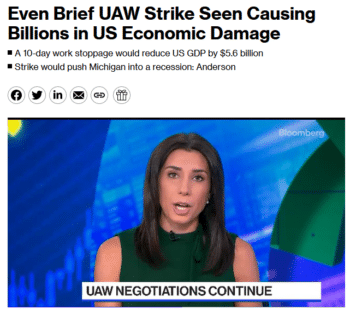
A brief UAW strike could reduce U.S. GDP by 0.02%—though that’s not how Bloomberg (9/10/23) chose to report the number.
The consulting firm also warned that a “Potential UPS Strike Could Be Costliest in a Century.” Further, they published a dubious study asserting that “electric vehicles can be more expensive to fuel,” and released a study in June 2020 that claimed looting during Black Lives Matter protests cost businesses in major cities $400 million, a number picked up by Fox (6/5/20), the New York Post (6/12/20) and others.
To be clear, this $5.6 billion number comes from estimating a 10-day strike of all 143,000 United Auto Workers (UAW) members. Given the stand-up strike strategy, which involves striking a few seemingly random plants at a time, it’s unlikely that all members will be on the picket line anytime soon.
Still, outlets continue to threaten recession, or if they cannot do that, at least mention the strike’s ability to “put pressure on new car prices” (Wall Street Journal, 9/22/23). As the UAW’s Fain noted in a video on September 18, the average price of a new car is up 30% over the past four years. “You think UAW wages are driving up that increase?” he asks. “Think again.”
As the car prices line exemplifies, corporate media love to present the everyday person as a consumer, someone who should be worried about car prices, rather than a worker who should be enthusiastic about labor’s resurgence.
In that vein, while asked on CNN (9/12/23) about the UAW strike damaging the economy, Fain responded:
It’s not that we’re going to wreck the economy. We’re going to wreck their economy, the economy that only works for the billionaire class. It doesn’t work for the working class.
Paige Oamek is a writer and factchecker based in New York. Their writing appears in In These Times, The Nation and elsewhere.

